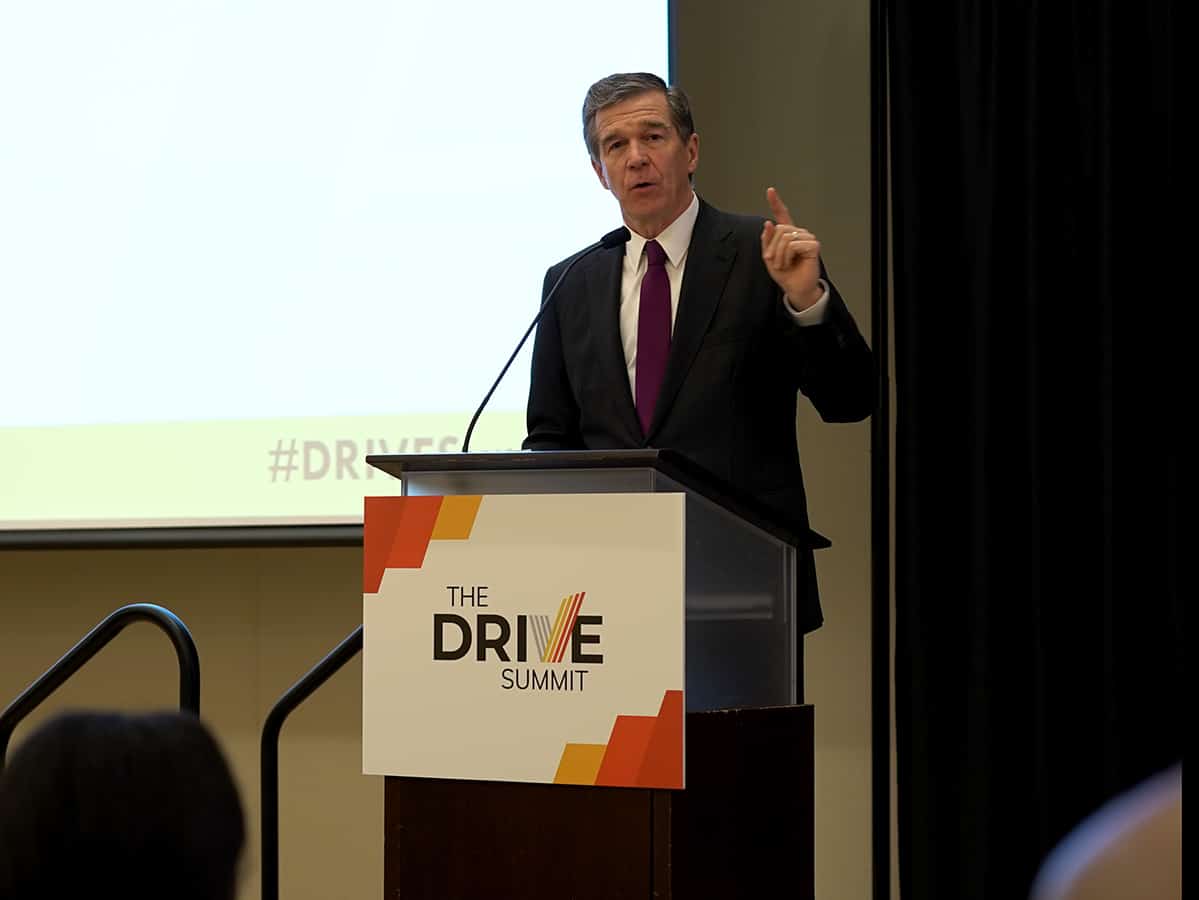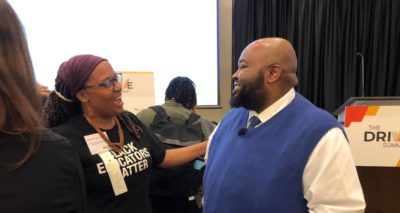
The DRIVE Task Force met on Tuesday to continue the work of getting, supporting, and keeping teachers of color in North Carolina.
DRIVE stands for Developing a Representative & Inclusive Vision for Education.
“The work that you all are doing is needed now more than ever,” said Kristi Jones, Governor Roy Cooper’s chief of staff.
In December of last year, the governor established the DRIVE Task Force “to tackle the issue and measure goals to get to the kind of workforce we need for every child to have a chance.”
This followed on from the DRIVE Summit at N.C. State on December 10, 2019. Put together by the Office of Gov. Roy Cooper, The Hunt Institute, and the NC Business Committee for Education, the summit was one of the largest gatherings of educators of color in the history of North Carolina.
The focus of Tuesday’s meeting — the task force’s second — was “dedicated to understanding the challenges and opportunities around recruiting racially and ethnically diverse educators,” according to an email about the task force meeting.
At the start of the meeting, Jones talked about the DRIVE Summit back in December and how the world has changed since then. She said teachers have become even more valuable “with COVID and remote learning and realizing the inequities that are in our schools … and then the most recent social unrest … reigniting our attention to the inequities in society.”
Anthony Graham, chair of the task force and provost of Winston-Salem State University, began the actual meeting by saying the names of Black people who have been killed by police. He then talked about the unrest in the wake of the killing of George Floyd by a police officer in Minneapolis.
Graham said that he disagrees with people when they say that the system is broken.
“I contend the system is operating as designed,” he said.
He talked about how inequity in modern systems is rooted in the days of slavery in the United States and said that the “formal schooling process” was designed with inequity in mind, saying it was “conceptualized, designed, and executed by white people for white people.”
He said he is pleased to see the “multiethnic, multiracial protests occurring across this nation and across the world as people demand a change,” and that teacher preparation departments need to be rooted in theories of anti-racism, for the sake of teachers and their students.
“They must feel valued, respected, and appreciated, and they must demonstrate to all of their students, but particularly their Black and brown students, that they too are valued, respected, and appreciated.”
Graham spent eight minutes and 46 seconds speaking at the top of the meeting. That was the amount of time Minneapolis police officer Derek Michael Chauvin kneeled on Floyd’s neck before he died.
Maria Hyler, deputy director of the Washington, D.C. office and senior researcher at the Learning Policy Institute, talked about both the advantages to having teachers of color and also some of the barriers to getting more into the teacher pipeline.
She talked about how teachers of color can fill hard-to-staff positions, boost academic performance, improve attendance rates, influence school climate, improve satisfaction, and offer benefits to all students.
According to a report from the Learning Policy Institute, the percentage of teachers of color in the teaching workforce has gone up from 12% to 20% in the past 30 years. The percent of first-year teachers who were non-Caucasian in 2015 went up to 25% from 10% in the 1980s. But according to the report, the makeup of the teaching workforce does not meet the diversity of the population at large or the population of students. People of color make up about 40% of the population and 50% of students.
However, people of color wanting to become teachers face barriers, including the cost of college. She said that people of color are more likely to report that student debt influences their career choices, and Black college graduates are likely to owe more money than their Caucasian counterparts years after graduation.
She referenced some programs North Carolina has that can help increase teachers of color in the classroom, including the NC Teaching Fellows Program and teacher residency and grow-your-own programs. She talked about the need to expand their impact.
Other recruitment policies that can help, according to Hyler, are teaching conditions in schools, as well as data and licensure policies that keep track of the diversity of the teaching workforce.
Here is a report that goes deeper into the issue from the Learning Policy Institute.
Denise Pearson, vice president of academic affairs and equity initiatives at the State Higher Education Executive Officers Association (SHEEO), presented on Project Pipeline Repair, a project of SHEEO that seeks to bolster the participation of minority male students in educator preparation programs.
On the scope of the crisis facing the nation when it comes to getting teachers of color, Pearson said the problem goes back a long time. She said that after Brown v. Board of Education, more than 35,000 African-American teachers lost their jobs and admissions requirements later changed, resulting in a negative impact on African-American enrollment in educator preparation programs.
She said the goal of Project Pipeline Repair is to help states develop policies and practices that can address the teacher shortages and increase teacher diversity, among other things. In particular, the project looked at what role Historically Black Colleges and Universities (HBCUs) can play.
“I see HBCUs as pioneers of culturally responsive pedagogy,” she said, adding later: “They are a natural resource. They are not obstacles to diversity and integration.”
She noted that many HBCUs started out as teaching colleges and that the educator preparation programs at these colleges and universities can be leveraged.
HBCUs are preparing teachers to serve high-need, high-poverty schools, respond to “contemporary matters including curriculum and culture,” and that the “historical mission of institutions remain relevant,” all things that are needed in this day and age, Pearson said.
Pearson described some of the lessons learned from Project Pipeline Repair that show what elements help and hinder the diversification of the teaching workforce.
Some things that help:
- Teacher loan forgiveness
- Dual credit/concurrent enrollment
- Grow your own/teacher cadet models
- Mentorship programs
Some things that hinder:
- Institutions not committed to HBCUs
- Current teacher certification requirements
- Admission barriers
- Lack of extended support for new teachers.
Read more about the work of Project Pipeline Repair here:
Terrik Higgins, program administrator of the Alternative Certification Track at Guilford County Schools, gave an overview of his program.
Started back in 2008, the Guilford County Schools Alternative Certification Track (GCS-ACT) puts lateral entry teachers through a 10-day orientation in the hope that it will better prepare them for the responsibilities of the classroom and lead to better teacher retention. It provides individualized coaching and a cohort model of professional development as well.
In 2012, the GCS-ACT began to focus on increasing minority teachers. There was a lack of teacher candidates in STEM licensure areas coming out of colleges and universities, so the program created partnerships with four HBCUs to recruit minority candidates from STEM majors to teach in high-need schools.
These teachers received more than 290 hours of training in the North Carolina Professional Teaching Standards and Praxis II preparation materials and courses to help with passing the exam, among other benefits.
The program graduated more than 500 teachers as of 2019. Read more about it here.
Finally, Margarita Bianco, an associate professor at the University of Colorado Denver, presented on Pathways2Teaching (P2T).
This is a “college readiness program” for juniors and seniors in high school “to explore issues in education, social justice and equity, and teaching as a potential career choice.”
Bianco said part of the reason she developed this program stemmed from her experience as a Latina student growing up.
“I wanted to become a teacher because I wanted to become the teacher I never had,” Bianco shared.
Bianco explained how her program is different from some traditional teacher cadet programs, including in its mission. The program seeks “to create a new generation of equity minded community responsive teachers who want to teach in their communities & disrupt educational inequities,” according to her presentation.
Pathways2Teaching was also created by a “scholar of color,” Bianco herself, whereas many cadet programs are designed by Caucasian women, she said.
Bianco added that the program isn’t just looking to develop teachers; it wants to create “critical educators,” or people who can think critically about the system they’re within. She said the program includes support for teachers and students throughout the year. And she said she was intentional when starting the program to make sure it wasn’t grant funded, because she was worried that if the grant money went away, the program would too.
Bianco said that when teachers of color and American Indian teachers think about teaching, they often have different priorities from traditional teachers.
Things like a focus on social justice, “racial uplift,” wanting to work in low-income schools, and wanting to be role models can all be motivators for teachers of color, Bianco said. She made sure to make all of those elements part of her program.
Bianco said that while most high school grow-your-own teacher programs claim to want to attract students of color, their requirements tell a different story. Requiring a 3.0 GPA, using a “‘traditional’ White Eurocentric Curriculum,” and not being “informed by a critical theoretical lens,” can all be barriers for students of color. These are things she specifically tried to avoid in her program, including not having a GPA requirement to enter.
Read more about the program here.


